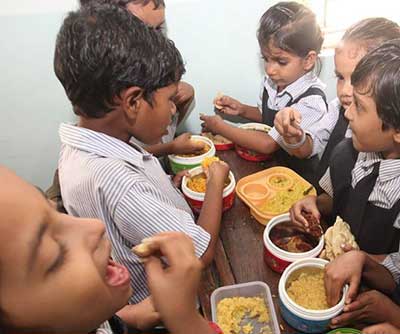Relevance: GS-2: Government Policies and Interventions for Development in various sectors and Issues arising out of their Design and Implementation; Issues relating to Poverty and Hunger.
Key Phrases: Rights based approach; NFSA 2013; NFHS-V; legal entitlement in People’s Union of Civil Liberties vs Union of India and Others (2001)
Why in News?
- From the next academic session, Karnataka is likely to become the 13th
state to provide eggs under the midday meal scheme
- This scheme is among the largest initiatives in the world to enhance nutrition levels of school-going children through hot cooked meals.
Key Highlights
- Although the proposal faces opposition and awaits the Karnataka
government’s final stamp of approval, it can fight high prevalence of
malnutrition, anaemia and low immunity among children in many parts of the
state
- National Family Health Survey-V found 35% children under five stunted, and around 20% wasted.
What is the history of the scheme?
- The programme, renamed as PM Poshan Shakti Nirman or PM Poshan in
2021, traces its roots to 1995; it was launched as a
centrally sponsored scheme on August 15 that year across 2,408 blocks
for students up to Class 5.
- In 2007, the UPA government expanded it to Class 8.
- Evolution
- 1920 - Madras Municipal Corporation starts the first initiative to provide meals to children
- 1956 - Tamil Nadu pioneers, with Chief Minister K Kamaraj rolling out a school feeding scheme
- 1961 - Kerala had a school lunch scheme run by a humanitarian agency from, which was taken over by the state government in 1984, making Kerala the second state in the country to have a school lunch programme.
- 1995 - Centre steps in 1
What is the scale of the scheme today?
- Coverage
- Covers 11.80 crore children across Classes 1 to 8 (age group 6 to 14) in 11.20 lakh government and government-aided schools
- As per National Food Security Act, 2013 (NFSA).
- In the Budget for 2022-23,
- The Centre has earmarked Rs 10,233 crore for the scheme, while the
- States are expected to spend Rs 6,277 crore.
- In the Budget for 2022-23,
- It is a legal entitlement of all school-going children in primary and upper primary classes, through the National Food Security Act (NFSA), 2013, as well as the Supreme Court’s ruling in People’s Union of Civil Liberties vs Union of India and Others (2001).
What is usually on the menu?
- The menu varies from one State or Union Territory to another.
- The nutritional component of the meal made up of rice, pulses, vegetables, oil and fat
- For Primary School children - at least 450 calories and 12 gm protein to children
- For upper primary children - 700 calories and 20 gm protein.
- The variations are in the cases of additional items such as milk, eggs, chikki, or fruits that the states provide as supplementary nutrition, the expenses for which are borne by the state government.
How wide are these variations in supplementary nutrition?
- Eggs, and bananas to vegetarians, are currently provided
only by 13 states and three UTs.
- Tamil Nadu provides eggs on all school working days;
- Andhra Pradesh, at least five days a week;
- Telangana and Andaman and Nicobar Islands, thrice a week;
- Milk is provided by Gujarat, Karnataka, Kerala, Madhya Pradesh, Mizoram, Rajasthan, Uttarakhand, Ladakh and Puducherry.
- Among other food items,
- West Bengal provides cheese and mushroom on a limited scale, while
- Andhra Pradesh and Maharashtra provide chikki.
- Lakshadweep, chicken is provided.
Why are eggs part of the menu in so few states and UTs?
- It is costly.
- Dietary choices are an intensely contested area in India due to caste rigidities, religious conservatism and regional differences
- The debate becomes political too.
Case Study
- Chhattisgarh, found a low quantity of protein in 30-35% of the samples from meals it tested, its decision to give eggs ran into political opposition.
- Madhya Pradesh, the previous government’s decision to add eggs to the menu of anganwadis was overturned by the current government in 2020.
- Karnataka, proposals to add eggs have been fiercely resisted in the
past by Lingayat and Jain seers
- But this has been handled well by states by providing alternatives such as fruits
Do the Centre and states run the scheme jointly?
- Under the rules, the allocation of Rs 4.97 per child per day
(primary classes) and Rs 7.45 (upper primary) are shared in
- 60:40 ratio with states and UTs with a legislature, and
- 90:10 with the Northeastern states, Jammu and Kashmir, Himachal Pradesh and Uttarakhand,
- Centre bears 100% of the costs in UTs without legislature.
But the states and UTs that supplement the meals with additional items such as milk and eggs contribute more.. However, the Centre bears the entire cost of foodgrains and their transportation, and also handles the expenditure on management, monitoring and evaluation of the scheme.
Source: Indian Express
Mains Question
Q. Explain the debate about introducing supplementary items like eggs in the Midday Meal Scheme? Also explain the centre’s and state’s role in this scheme.









